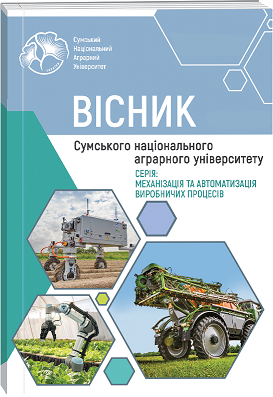ВИЗНАЧЕННЯ КОЛОВОЇ ЖОРСТКОСТІ НАВІСНОЇ СИСТЕМИ ТРАКТОРА ПРИ ПРОВЕДЕННІ ТЕХНОЛОГІЧНОЇ ОПЕРАЦІЇ
Анотація
У статті розглянуті питання щодо визначення колової жорсткості навісної системи трактора. Сучасні системи навішування мають доволі просту, але в той же час і складну систему приєднання сільськогосподарської машини до енергетичного засобу. Навісна система являє собою шарнірно-важільний механізм, розміщений ззаду або спереду трактора. Доволі часто універсально-просапні трактори мають обидві навіски. Їх функції практично однакові, але вага машин, які агрегатуються з трактором дещо різняться між собою. Все залежить від способу приєднання машин до трактора. Традиційно навісні машини розміщують на обох навісках, але на передній – розміщують легші машини. Це обумовлено меншими можливостями щодо навантаження переднього мосту трактора, плюс необхідністю доброго переднього огляду із кабіни трактора. Відносно жорсткості навісної системи можна сказати, що таких досліджень вкрай мало. Справа в тому, що конструкція самої навіски є масивною і такою, що не викликає сумнівів у її надійності. Однак сучасні сільськогосподарські машини, які мають ширину захвату 8 і більше метрів, мають і значну масу в порівнянні з іншою технікою з меншою шириною захвату. Тому виникає законне питання щодо жорсткості і навішувальної здатності навісних систем тракторів. В представленій статті розглянуто теоретичне питання визначення жорсткості навісної системи трактора під час проведення технологічної операції сівби сільськогосподарської культури. Визначені теоретичні залежності показують зміну величини кута відхилення сівалки від траєкторії руху трактора. Отримані теоретичні рівняння можуть бути корисними при проектуванні навісних сільськогосподарських машин. Завдання зводиться до визначення залежності між пружним розтягуванням ланцюга та кутом повороту сівалки. Для цього розглянемо чотирикутник, що символізує навісну систему, де одні шарніри є точками кріплення нижніх тяг до нижньої осі навіски трактора, а інші – точками кріплення до сівалки. Штрих пунктирними лініями вказані пружні елементи – обмежувальні ланцюги. При цьому нас цікавитимуть кути повороту сівалки щодо трактора, та кут повороту нижньої тяги навіски. Проведені теоретичні дослідження показали значимість показника жорсткості навісних систем тракторів. Отримана залежність показала, що основними показниками при визначенні жорсткості є момент від сили пружності обмежувального ланцюга і кут повороту нижньої тяги механізму навіски. В свою чергу сила пружності обмежувального ланцюга залежить від матеріалу, з якого від виготовлений, і терміну роботи всієї навісної системи.
Посилання
2. Semenov V. M. (1981). Rabota na traktore [Working on a tractor]. Moskva : Kolos. 271 p. (in Russian).
3. Hrechkosiy V. D. (1988). Dovidnyk sil’s’koho inzhenera [Handbook of rural engineer]. Kiev : Urozhay. 360 p. (in Ukrainian).
4. Makarenko M. H. (2012). Navisni systemy traktoriv [Tractor mounted systems]. Kiev : Mechanization of agro-industrial complex. № 6. Pp. 20–24. (in Ukrainian).
5. Pavlyuk A. S., Kalinin R. A. (2009). Povysheniye ustoychivosti i upravlyayemosti mobil’nykh mashin za schet konstruktsii tyagovo-stsepnogo ustroystva [Improving the stability and controllability of mobile machines due to the design of the towing device]. Yekaterinburg : Polzunovskiy vestnik. № 1-2. Pp. 119–122. (in Russian). 6. Popov V. B. (2008). Avtomatizirovannoye proyektirovaniye mekhanizma naveski perednego podyemno-navesnogo ustroystva universal’nogo yenergosredstva [Computer-aided design of the linkage mechanism of the front lifting-hinged device of a universal power source]. Minsk : Mekhanizatsiya i elektrifikatsiya sel’skogo khozyaystva: mezhvedomstvennyy tematicheskiy sbornik. Vyp. 42. pp. 3–12. (in Belarussian).
7. Artobolevskiy, I. I. (1988). Teoriya mekhanizmov i mashin [Theory of mechanisms and machines]. Moskva : Mashinostroyeniye. 640 p. (in Russian).
8. Guskov, V. V. (1981). Traktory. Chast 3. Konstruirovaniye i raschet [Tractors. Part. 3. Design and calculation]. Minsk : Vysshaya shkola. 383 p. (in Russian).
9. Vodyanyk I. I. (1994). Ekspluatatsiyni vlastyvosti traktoriv i avtomobiliv [Performance properties of tractors and cars]. Kiev : Urozhay. 224 p. (in Ukrainian).

 ISSN
ISSN  ISSN
ISSN 



